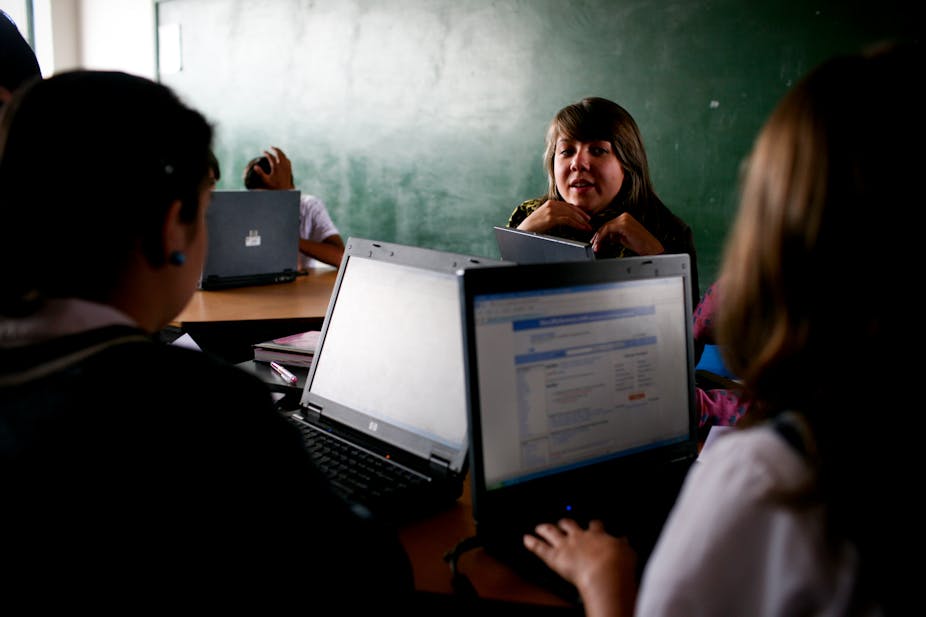The Final Report of the Review of the Australian Curriculum is seriously flawed. Many aspects of the report have attracted comment – but the recommendation that schools do away with a major, world-leading innovation has not.
For the first time, media arts, one of the five strands of the Arts curriculum, was to become a compulsory subject for primary school students. This will no longer be the case if the Review’s recommendations are adopted by the government.
The Review recommends removing media arts from the mandatory arts strands, and “substantially reducing” its content. Rather than being an integrated part of the arts curriculum, media arts would become a “stand alone” subject.
Further implicit in the Review is the assumption that some media arts content will be, or already is being, covered in other learning areas “such as English, health and physical education, history and technologies”.
This is not only wrongheaded: it is ignorant of the essential role that media arts plays in digital media literacy education.
What is media arts?
In media arts, students both make and respond to media works.
“Making” media involves students learning technical production skills such as how to frame and compose a shot, how to record sound, how to edit image and sound tracks, and how to add visual and sound effects.
Such skills are important for developing conceptual knowledge, for recognising how media works are constructed. They also enable students to use media to communicate and tell stories – and complete assignments, as many students increasingly use digital media to do.
“Responding” involves analysing media works with the goal of assisting students to become active and ethical media creators, users and consumers. Students learn about how media works - including, ideally, social media. They learn about key issues and practices such as copyright, the creative commons, and the ethics of sharing media works and personal information online.
Digital literacy for our times
It is insufficient to suggest, as the Review does, that the slack can be taken up in subjects like English or ICT. While media studies is part of the English curriculum in some States, this rarely if ever involves media production. And while students may learn about media technologies in ICT, there is very little if any emphasis on storytelling or communication ethics.
Other learning areas might teach some aspects of digital media literacy, but unless they are deliberately spread across the curriculum, only media arts will teach them holistically.
The Review further justified the marginalisation of media arts by highlighting the costs of resourcing the curriculum and providing the necessary professional development opportunities for teachers, particularly at primary level.
It is true that teaching media arts can be costly, but so are many other learning areas. Education budgets are limited, and schools and education authorities are justifiably concerned about rising technology and access costs. And the primary curriculum is already crowded.
But the key point is that digital media literacy is as vital as reading, writing and numeracy for children’s futures. Misrecognising this has the potential to detrimentally affect young people’s prospects of prospering in the 21st century digital economy.
The basics of digital media making can be taught on many kinds of device, using free or low cost technologies and software. Schools can make use of a growing number of online resources and services to facilitate responses to or analyses of media works. Some of these services, such as ABC Splash, are free to access and use, and cover a range of learning areas.
Skills for the future
The need for Australian children – indeed, all Australians – to develop competencies and formal skills to use and understand digital media has never been greater. Alongside almost ubiquitous use for leisure, more and more jobs now and in the future will require engagement with digital media content and technologies.
Many children already live thoroughly mediated lives.
They produce, communicate and consume media via smartphones, televisions, tablets or other computers, and an ever growing range of other devices, both at school and especially outside school time. Many children informally develop extraordinary capabilities with digital media content and devices. But such vernacular digital literacy may not fully equip them to deal with the many challenges and opportunities of contemporary life.
We must be wary of falling in to the trap of assuming that any child is a “digital native” and so does not need formal education in digital technologies, how the media work, or the ethics and implications of sharing and communicating via social media.
For me, the term digital native wrongly implies that children innately understand digital technologies and content, and that they will naturally evolve the ability to use digital media. They will not. Competencies, skills and understandings need to be taught, learned, and practised.
One distinguished media educator gave me the analogy of a child entering kindergarten. While they may be able to use language and hold a conversation, they need to learn how to form sentences. They need to be taught how to write. The same is true for their engagements with media.
Every young person needs to know how to participate creatively, safely and ethically in digital media culture. Only media arts teaches students how to engage with and understand the media through making and responding to media. Only media arts teaches children and young people how to creatively tell stories and communicate with digital images, sounds and texts.
Its benefits are immense, life-long, and vital to the futures of Australia’s children. Rather than being downsized and made an optional extra, media arts should be at the very core of the 21st century Australian Curriculum.

